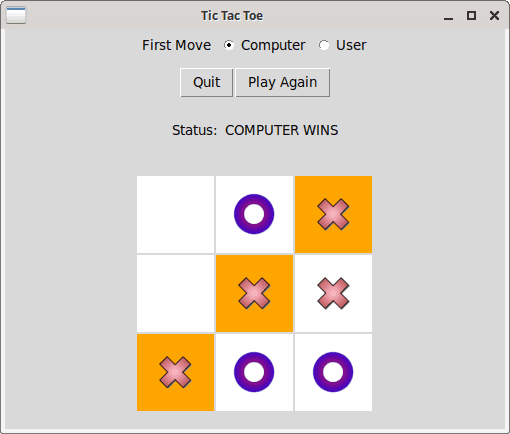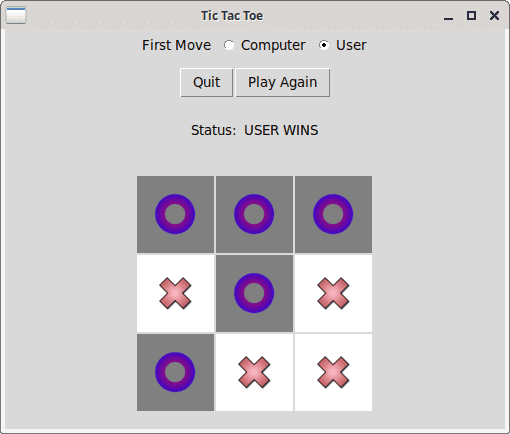Tic Tac Toe GUI
This section will show how to create a GUI for Tic Tac Toe using tkinter. User will play against the computer. To keep it simple, computer moves will be just a random selection. Smarter computer move will be discussed in a later section.
Layout
There are several ways to prepare before you start coding your GUI. Creating a rough sketch of how your GUI should look with pen and paper is often recommended. Here's one possible list of requirements:
- Options to choose who moves first
- Quit (close the window, optional)
- Start a game/play again
- Display information about the current game status
- The game board
Both the grid() and pack() layout techniques will be used here. You cannot mix different layout methods, but you can use different frames to group and isolate widgets based on layout requirements.
Code
# tic_tac_toe.py
import random
import tkinter as tk
class Root(tk.Tk):
def __init__(self):
super().__init__()
self.title('Tic Tac Toe')
self.geometry('500x400')
self.char_x = tk.PhotoImage(file='./char_x.png')
self.char_o = tk.PhotoImage(file='./char_o.png')
self.empty = tk.PhotoImage()
self.active = 'GAME ACTIVE'
self.total_cells = 9
self.line_size = 3
self.computer = {'value': 1, 'bg': 'orange',
'win': 'COMPUTER WINS', 'image': self.char_x}
self.user = {'value': self.line_size+1, 'bg': 'grey',
'win': 'USER WINS', 'image': self.char_o}
self.board_bg = 'white'
self.all_lines = ((0, 1, 2), (3, 4, 5), (6, 7, 8),
(0, 3, 6), (1, 4, 7), (2, 5, 8),
(0, 4, 8), (2, 4, 6))
self.create_radio_frame()
self.create_control_frame()
def create_radio_frame(self):
self.radio_frame = tk.Frame()
self.radio_frame.pack(side=tk.TOP, pady=5)
tk.Label(self.radio_frame, text='First Move').pack(side=tk.LEFT)
self.radio_choice = tk.IntVar()
self.radio_choice.set(self.user['value'])
tk.Radiobutton(self.radio_frame, text='Computer',
variable=self.radio_choice, value=self.computer['value']
).pack(side=tk.LEFT)
tk.Radiobutton(self.radio_frame, text='User',
variable=self.radio_choice, value=self.user['value']
).pack(side=tk.RIGHT)
def create_control_frame(self):
self.control_frame = tk.Frame()
self.control_frame.pack(side=tk.TOP, pady=5)
self.b_quit = tk.Button(self.control_frame, text='Quit',
command=self.quit)
self.b_quit.pack(side=tk.LEFT)
self.b_play = tk.Button(self.control_frame, text='Play',
command=self.play)
self.b_play.pack(side=tk.RIGHT)
def create_status_frame(self):
self.status_frame = tk.Frame()
self.status_frame.pack(expand=True)
tk.Label(self.status_frame, text='Status: ').pack(side=tk.LEFT)
self.l_status = tk.Label(self.status_frame)
self.l_status.pack(side=tk.RIGHT)
def create_board_frame(self):
self.board_frame = tk.Frame()
self.board_frame.pack(expand=True)
self.cell = [None] * self.total_cells
self.board = [0] * self.total_cells
self.remaining_moves = list(range(self.total_cells))
for i in range(self.total_cells):
self.cell[i] = tk.Label(self.board_frame, highlightthickness=1,
width=75, height=75, bg=self.board_bg,
image=self.empty)
self.cell[i].bind('<Button-1>',
lambda e, move=i: self.user_click(e, move))
r, c = divmod(i, self.line_size)
self.cell[i].grid(row=r, column=c)
def play(self):
self.b_play['state'] = 'disabled'
if self.b_play['text'] == 'Play':
self.create_status_frame()
self.b_play['text'] = 'Play Again'
else:
self.board_frame.destroy()
self.l_status['text'] = self.active
self.state = self.active
self.last_click = 0
self.create_board_frame()
if self.radio_choice.get() == self.computer['value']:
self.computer_click()
def quit(self):
self.destroy()
def user_click(self, e, user_move):
if self.board[user_move] != 0 or self.state != self.active:
return
self.update_board(self.user, user_move)
if self.state == self.active:
self.computer_click()
def computer_click(self):
computer_move = random.choice(self.remaining_moves)
self.update_board(self.computer, computer_move)
def update_board(self, player, move):
self.board[move] = player['value']
self.remaining_moves.remove(move)
self.cell[self.last_click]['bg'] = self.board_bg
self.last_click = move
self.cell[move]['image'] = player['image']
self.cell[move]['bg'] = player['bg']
self.update_status(player)
self.l_status['text'] = self.state
if self.state != self.active:
self.b_play['state'] = 'normal'
def update_status(self, player):
winner_sum = self.line_size * player['value']
for line in self.all_lines:
if sum(self.board[i] for i in line) == winner_sum:
self.state = player['win']
self.highlight_winning_line(player, line)
if self.state == self.active and not self.remaining_moves:
self.state = 'TIE'
def highlight_winning_line(self, player, line):
for i in line:
self.cell[i]['bg'] = player['bg']
if __name__ == '__main__':
root = Root()
root.mainloop()
Explanation for frames
- Initial screen shows two frames at the top — radio and control.
- User gets to play the first move by default, which can be changed by choosing the
Computeroption. Quitbutton is active all the time, allows the user to close the application.Playbutton is responsible for creating a new game. After the first click, the text changes toPlay Again.
- User gets to play the first move by default, which can be changed by choosing the
- The status frame holds two labels to indicate the current state of the game. This becomes visible when the
Playbutton is clicked.- There are three states —
GAME ACTIVE,TIEand victory for one of the players (COMPUTER WINSorUSER WINS).
- There are three states —
- The board frame creates the grid of labels representing the game area. This becomes visible when the
Playbutton is clicked.- Left button click for each cell is handled by the
user_click()method.
- Left button click for each cell is handled by the
The side=tk.TOP option sets the top position for radio and control frames. This is chosen since the other two frames are created only after the Play button is clicked. If you prefer, you can choose to add a help text about the game rules when the application is first launched.
Explanation for variables
statetracks the current state of the game. You could technically use thetextparameter of the status label as well, but separate variable will help if you want to split the code into separate classes for game logic and UI.total_cellsandline_sizedon't have much use in this particular code, but it will help if you want to extend the game to support multiple board sizes.computeranduserdictionaries store player information. This allows methods likeupdate_board()to work for both players based on which dictionary is passed as an argument.all_linesstores indexes of all valid lines (8 lines in total for 3x3 board).remaining_moveslist keeps track of available moves. Whenever a user/computer move is made, that particular index is removed from this list.boardlist keeps track of which player has made a move for a particular cell using thevaluekey from the player's respective dictionary.celllist is the equivalent for image labels.
last_clickkeeps track of which cell was last updated. Since there is no delay implemented for computer moves in this code, effectively you'll see only the last computer move highlighted. The only exception is if a game ends in aTIEand the last move was made by the user.
Explanation for game logic
- Once the user clicks the
Playbutton, the status and board frames show up.- Initial status shows game in active state.
- For
Play Againbutton, the old board frame is destroyed before creating the new board. - If
Computerplays first was chosen, one computer move is made.
- All computer moves are random in this particular project. Coding a smarter move will be discussed later.
- When the user clicks one of the image labels:
returnwithout further processing if the game is not active or if a valid move is already made on that cell.- Otherwise, the board is updated using the
update_board()method. - Then, if the game is still active, another computer move is made.
update_board()method:- Based on the player dictionary and move index passed, the
board,cell,last_clickandremaining_movesvariables are updated. - Once the move is completed, status is updated. If the game is no longer active,
Play Againbutton's state is changed tonormal.
- Based on the player dictionary and move index passed, the
update_status()method:- Game ends if one of the player wins or if all the cells have been clicked (resulting in a
TIE). - Iterate over the
all_linestuple and calculate the sum of values of each index from a particular line.- If the sum equals 3 (i.e.
line_size) times the player value, then it is a winning line. highlight_winning_linemethod will highlight such a line by changing the background of all indexes for this line.- Note that there can be multiple winning lines.
- If the sum equals 3 (i.e.
- Game ends if one of the player wins or if all the cells have been clicked (resulting in a
Screenshots

